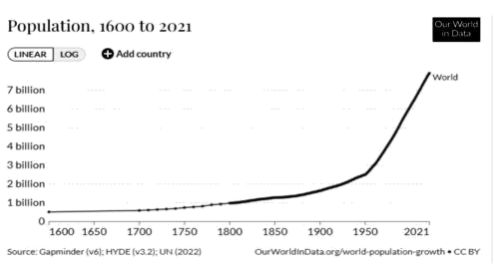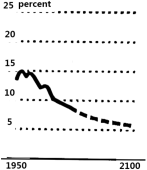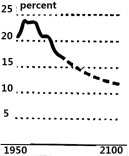1 . On November 15 in 2022, the United Nations (UN) reported that the number of people on Earth had grown to eight billion (8,000,000,000). That came just 11 years after the world reached seven billion people. The world faces challenges ahead as the population continues to grow.

The world’s population – the number of people on the planet – has grown rapidly over the last 200 years. In 1805, for the first time ever, the Earth had a billion people on it. It took over 100 years for that number to double to two billion. In less than 50 years, it had doubled again to four billion. Now, again in less than 50 years, the number has doubled once more to eight billion.
How fast local populations are growing depends a lot on where you are in the world. Typically, as countries become richer, their population growth slows. In some countries, like Japan, the number of people is actually shrinking. The greatest population growth these days is found in Asia and Africa.
Currently, China, with a population of 1.4 billion, is the country with the most people. That’s expected to change in the next year, when experts say India will pass China as the country with the world’s largest population. Other countries where rapid growth is expected through 2050 are the Democratic Republic of the Congo, Egypt, Ethiopia, Nigeria, Pakistan, the Philippines, and Tanzania.
1. When did the world’s population reach 7 billion?| A.In 2022. | B.In 2011. | C.In 1905. | D.In 1805. |
| A.Japan’s population is increasing sharply. |
| B.Pakistan’s population keeps dropping slowly. |
| C.A country’s population completely relies on its richness. |
| D.The world’s population is growing more rapidly since 1950. |
| A.China. | B.Nigeria. | C.India. | D.Egypt. |
2 . The Chinese government ends its one-child policy (政策) and allows families to have three children. The policy is meant to balance population development, stop a falling birth rate (出生率) and strengthen the country’s labor force (劳动力).
China, with the largest population in the world, started the one-child policy in 1980. But the government allowed only a small number of couples to have two children. For example, some families in the countryside could have two children, if the first-born child is a girl. In 2016, the Chinese government gave other couples a chance to have two children if one of them was an only child. Because of aging of population, in 2021, it allowed families to have three children.
To the newest policy, different families have different opinions. “Too many young people in the cities are no longer interested in having two or three children,” an official said. “People in the countryside are more interested.”
At the end of 2021, China had a population of more than 1.4 billion people. A total of 900 million of them have jobs. But the labor market population will drop in 30 years. That is to say, the country will be in great need of labor by the year 2050. With the three-child policy, an increase in births can solve this problem.
Boys and girls, what do you think of the three-child policy? Do you want to have new-born brothers or sisters?
1. Why does the Chinese government end the one-child policy?| A.Because China needs a larger population. |
| B.Because a falling birth rate must be stopped. |
| C.Because most families want to have a second or third child. |
| A.20 years. | B.30 years. | C.more than 40 years. |
| A.They strongly support the policy. |
| B.They don’t think it is good. |
| C.They’re not interested in it any more. |
| A.In 2035. | B.In 2050. | C.In 2070. |
| A.The population development will be balanced. |
| B.The labor market population will drop. |
| C.There will be more old people. |
3 . For almost all of human history, the Earth's population has tended to be younger. But since the last World Population Day on July 11, a major shift occurred: There are now more people aged 65 and older than there are under age five.
World Population Day was established by the United Nations Development Program in 1989 to bring attention to population issues. Having more people on the planet is not the only concern, though, since a population's age structure matters too.
Increased lifetime is a remarkable human success story, but having more elderly people also creates a number of socioeconomic concerns. The global population will continue to age as these two groups grow in opposite directions. By 2100, the percentage of the population aged 65 and older will rise to nearly 25 percent — about five times that of children under five.
“Most developed countries have been aging for a century, giving them time to prepare for the changes. But developing countries will become old before they become rich,” says researcher Toshiko Kaneda. Many countries in Latin America and Asia are aging much faster and have less time and resources to prepare health-care systems.
What are the consequences of an older global population? Supporting elderly people is more expensive than caring for young ones. Pressing issues arise like how to provide long-term care, and maintain a labor force. In developed regions like Europe, where 10 percent of the population over age 50 is childless, elderly care is a major worry.
“Not a single country has been able to change declining trends in fertility (生育) despite government requests for people to reproduce as has been done across Europe and in Japan,” Kaneda says. “The aging trend is continuous. ”
But declining fertility rates can have positive effects too, says Kaneda. When fertility rates decline but the population hasn't aged yet, governments can spend more on secondary and higher education, and benefit the economy. Both Thailand and South Korea have seized the opportunity during this ideal period.
1. What do we know about the global population?| A.It tended to be younger until now. |
| B.People are living longer and having fewer kids. |
| C.Age structure matters more than population size. |
| D.Developed countries are facing tougher challenges. |
A. | B. |
C. | D. |
| A.Critical. | B.Objective. | C.Optimistic. | D.Doubtful. |
| A.The declining trend in the fertility rates. |
| B.The consequences of the aging population. |
| C.The establishment of World Population Day. |
| D.The present situation of the global population. |



